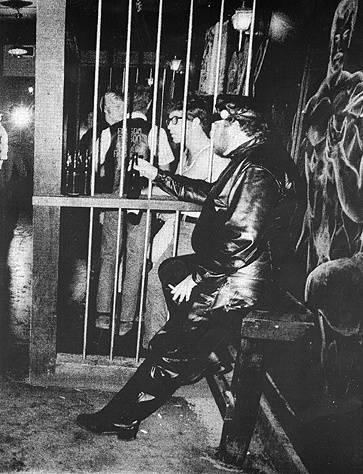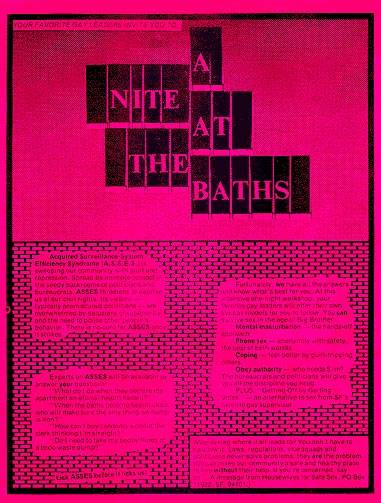Sex Panic Closes Bathhouses
Gay Nightclub Prison, 1970s
Photo: Crawford Barton
Before there were any openly gay or lesbian leaders, political clubs, books, films, newspapers, businesses, neighborhoods, churches or legally recognized gay rights, several generations of pioneers spontaneously created gay bathhouses and lesbian and gay bars. . . . [G]ay baths and bars became the first stages of a movement of civil rights for gay people in the United States. . . . Gay bathhouses represent a major success in a century-long political struggle to overcome isolation and develop a sense of community and pride in their sexuality, to gain their right to sexual privacy, to win their right to associate with each other in public, and to create safety zones where gay men could be sexual and affectionate with each other with a minimal threat of violence, blackmail, loss of employment, arrest, imprisonment, and humiliation. . . .
As a historian, it is clear to me that yet another government campaign to dismantle gay institutions, even in the well-motivated attempt to stop the spread of AIDS, will only backfire. . . . Instead of wasting its time defending its bathhouses, its bars, and its very right to exist, the gay community must be allowed to devote all its resources, including the bathhouses, toward promoting the research, health programs and safe sex educational measures that will save lives. (Brub 1984)
While bathhouse closure may appear tangential to the impact of AIDS on the leather community, the links are strong. Bathhouse closure exemplifies the way in which public policy decisions driven by misplaced passions often had unintended and unanticipated consequences. As with other sexually transmitted diseases, early attempts to explain and combat AIDS often assumed a profoundly moralistic cast that had little connection to the exigencies of epidemiological intervention. Sex prejudice, sex moralism, and sex panic often powered analysis and policy. (Brandt 1988; Brub 1988; Patton 1985; Triechler 1988)
Proponents of bathhouse closure, such as Randy Shilts, argued that their program was an obvious common sense measure to save lives. They portrayed the debate about closure as one pitting public health against civil liberties. Shilts in particular wrote as if public health professionals were in agreement on the desirability of closing the baths, and that only political considerations were preventing them from doing so. (Shilts 1987)
On the contrary, bathhouse closure, far from being an obvious public health measure impeded by political pressure, was a case of political pressure overwhelming public health considerations. Public health professionals were not unanimous about the necessity or desirability of closing the baths, which stayed open in most other cities. It is ironic that while there are still no legal gay bathhouses within the San Francisco city limits, establishments in nearby municipalities such as Berkeley and San Jose have continued to thrive.
It is arguable that what mattered in the long run was changing behavior, not its location. Closing the baths may have actually impeded the progress of safe-sex education. Even in situations where the ownership did not cooperate, safe sex was spreading, like the epidemic itself, from person to person, through sexual contact, as men would engage each other in discussions of what they were or were not about to do. Wholesale closure eliminated opportunities for sex education along with opportunities for sex. At the baths, the concentrated populations of those at high risk for AIDS provided opportunities for educators to disseminate condoms along with written guidelines for AIDS risk reduction. (Murray & Payne 1988; Bolton 1992)
The social costs of closing the baths were treated cavalierly. Those who pushed for closure appeared to assume that nothing important or good ever happened in the sex palaces. They failed to recognize the baths and sex clubs as important institutions that served many needs within a diverse gay male community. (Brub 1996) The major gay baths had deep pockets and expensive attorneys, and could afford a protracted legal fight. By contrast, many of the leather clubs were relatively small operations in which a dedicated owner had invested most of his capital and a great deal of personal commitment, and they could not afford prolonged litigation. Calls for closure quickly claimed most of the specialized leather, SM, and fisting sex clubs even before any city actions were taken, and as the agitation intensified, most of the men who ran the leather clubs elected to shut down and limit their losses. The wider social and economic fallout from closure was also substantial. While the owners of bathhouses were frequently vilified as greedy capitalists (and some undoubtedly were), the debates never grappled with the importance of the baths to gay male social life or the economic impact of closure on the gay economy.
New sexual spaces eventually began to reemerge by the end of the 1980s. Many were small, some were dirty, and most were ill-equipped and lacking in the accumulation of small improvements that had made the older clubs comfortable and sexy. Some of the clubs lacked even the most basic of the amenities taken for granted in the old facilities. The infrastructure of semipublic sex was degraded as a result.
This began to change only in 1992, with the opening of Eros and Blowbuddies, two clubs that permit only safe sex on the premises. They have been followed by others, and something of a sex club renaissance is now underway. The infrastructure of gay male commercial sex is being slowly rebuilt. Nonetheless, few of the current facilities can compare with the sex palaces of yesteryear. Nostalgia for those well-developed installations has contributed to recent calls in the local gay press for removing all of the regulations put in place by the closure campaigns. Instead, new regulations have been adopted. Removing the regulations might hasten the recovery of baths and sex clubs, but some changes are irreversible. One of these is the displacement of the gay and leather communities from the South of Market.
--Gayle Rubin, excerpted from "The Miracle Mile: South of Market and Gay Male Leather, 1962-1997" in Reclaiming San Francisco: History, Politics, Culture (City Lights: 1998)
This flyer was produced in 1983.
A Nite at the Baths
Experts on ASSES will be available to answer YOUR questions: "What do I do when they declare my apartment an official health hazard?" "When the baths become health clubs who will make sure the only thing we pump is iron?" "How can I buy condoms without the clerk thinking I'm straight?" "Do I need to take my bodily fluids to a toxic waste dump?"
Acquired Surveillance-System Efficiency Syndrome (A.S.S.E.S.) is sweeping our community with guilt and repression. Spread by intimate contact in the seedy backrooms of politicians and bureaucrats, ASSES threatens to deprive us of our civil rights. Its victims--typically promiscuous politicians--are overwhelmed by delusions of superiority and the need to police other people's behavior. There is no cure for ASSES once it strikes.
Fortunately, WE have all the answers and know what's best for you. At this intensive one-night workshop, your favorite gay leaders will offer their own lives as models for you to follow. You CAN survive sex in the age of Big Brother: MENTAL MASTURBATION--the hands-off approach PHONE SEX--anonymity with safety, the best of both worlds. COPING--feel better by guilt-tripping others. OBEY AUTHORITY--who needs S/M? The bureaucrats and politicians will give you all the discipline you need. PLUS: "Getting Off by Getting Votes"-an alternative to sex from SF's favorite gay supervisor.
Lick ASSES before it licks us! (Wondering where it all leads to? You don't have to swallow it. Laws, regulations, vice squads and politicians never solve problems, they ARE the problem. We can make our community a safe and healthy place to live WITHOUT their help. If you're concerned, say so. . . A message from Housewives for Safe Sex, PO Box 11622, SF, CA 94101.)


